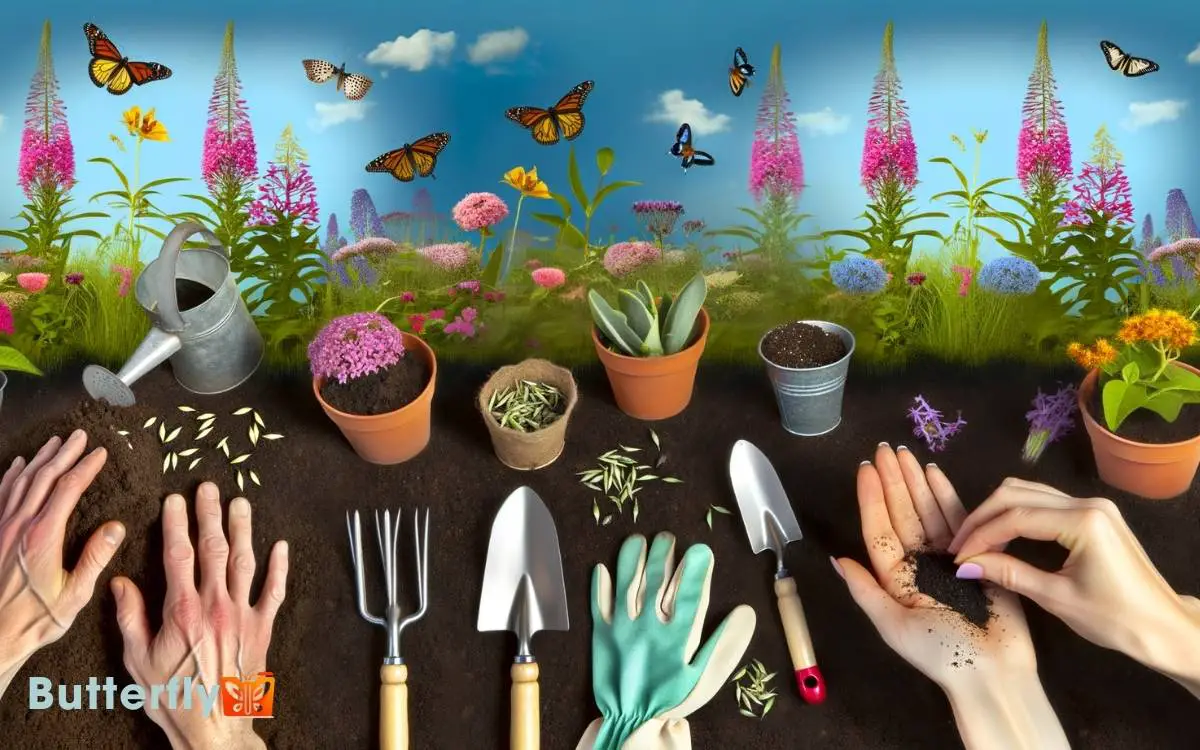How To Plant Butterfly Milkweed Seeds? Step-by-Step Guide!
To guarantee butterfly milkweed seeds grow successfully, start by selecting a sunny spot with at least 6 hours of light daily. Clear the area of weeds and debris, and amend the soil with organic compost for better drainage.
Choose stratified seeds from a reliable source. Sow seeds 1/4 inch deep and keep the soil moist without overwatering.
Mist the soil daily until seedlings emerge. Avoid over-fertilization and deadhead spent flowers to promote continuous blooming.
Apply mulch for moisture retention but keep it away from the stems. To secure success, there’s more to learn regarding transplanting and maintaining healthy plants.

Key Takeaways
Choosing the Right Location
Choosing the right location for planting butterfly milkweed seeds is crucial for their successful growth and development.
You’ll want to select a spot that receives full sunlight for at least six hours a day. Butterfly milkweed thrives in well-drained areas, so avoid locations prone to waterlogging. Consider the plant’s mature height and give each seed ample space to grow without crowding.
It’s advantageous to select a location sheltered from strong winds to protect the delicate stems. Additionally, integrating butterfly milkweed into a pollinator-friendly garden maximizes its ecological benefits.
Make certain the area is free from invasive species that might compete for resources. By carefully selecting the ideal site, you’ll establish the foundation for a thriving butterfly milkweed habitat.
Soil Preparation
After selecting the perfect spot, it’s vital to prepare the soil to ensure ideal conditions for butterfly milkweed seeds to germinate and thrive.
Begin by clearing the area of weeds, rocks, and debris. Butterfly milkweed prefers well-drained soil with a pH between 6. 0 and 7. 0. You can improve the soil by mixing in organic matter like compost to help retain moisture while ensuring proper drainage. Plant butterfly milkweed in a sunny spot, as it thrives in at least six hours of direct sunlight each day. For a pollinator-friendly garden, consider pairing it with butterfly bushes and coffee grounds to enrich the soil and attract beneficial insects.
To achieve this, you might need to amend the soil with organic compost or sand to enhance drainage and nutrient content.
Next, till the soil to a depth of at least 12 inches to loosen compacted layers and improve root penetration. Incorporate a balanced, slow-release fertilizer to provide essential nutrients.
Seed Selection
When selecting butterfly milkweed seeds, prioritize quality by looking for those that are firm, dark, and free from blemishes.
You’ve got several seed source options, including nurseries, online retailers, and local seed exchanges.
Confirm the seeds are sourced from reputable suppliers to guarantee high germination rates and healthy plants.
Choosing Quality Seeds
Ensuring you start with high-quality butterfly milkweed seeds is essential for a successful planting, as this directly impacts germination rates and plant health.
First, inspect the seeds for uniformity in size and color, as irregularities can indicate poor quality. Look for seeds that are plump and firm, avoiding those that are shriveled or damaged.
Opt for seeds that have undergone stratification, a pre-treatment process that enhances germination. Check the packaging for information on the seed’s harvest date; fresher seeds generally have higher viability.
Additionally, consider seeds that have been tested for purity and germination rates, which reputable suppliers often provide. By selecting premium seeds, you’re setting a strong foundation for vibrant and resilient butterfly milkweed plants.
Seed Source Options
Choosing the correct seed source for butterfly milkweed is crucial, as reputable suppliers guarantee high germination rates and healthy plants by providing well-documented seed quality.
To make sure you’re making the best choice, consider these innovative criteria:
- Seed Provenance: Opt for seeds sourced from native populations adapted to your local climate.
- Germination Rates: Look for suppliers that offer tested and certified high germination rates.
- Organic Certification: Prefer organically produced seeds to avoid chemical residues.
- Genetic Diversity: Select suppliers that emphasize genetic diversity to support resilient plant ecosystems.
- Customer Reviews: Check feedback for insights on supplier reliability and seed performance.
Sowing the Seeds
To start sowing the seeds, make sure the seedbed is well-prepared by loosening the soil to a fine texture.
Plant the seeds at a shallow depth, no more than 1/4 inch, to allow for proper germination.
Keep the soil consistently moist but not waterlogged to support initial growth.
Seedbed Preparation
Preparing the seedbed for butterfly milkweed requires meticulous soil preparation to guarantee the best germination and growth. First, clear the area of any debris, weeds, or old plant material.
Next, till the soil to a depth of 6-8 inches to make sure it’s loose and well-aerated. Incorporate organic matter, such as compost, to enhance soil fertility and drainage.
- Test soil pH: Aim for a pH between 6.0 and 7.0.
- Remove stones: Ensure a smooth, stone-free surface.
- Level the bed: Create an even planting surface.
- Moisten the soil: Provide adequate moisture without waterlogging.
- Rake the area: Achieve a fine, crumbly texture.
With these steps, you’re setting a solid foundation for your butterfly milkweed seeds to thrive.
Planting Depth
When sowing butterfly milkweed seeds, make sure they’re planted at a depth of 1/4 inch to maximize germination rates and seedling vigor. Use a calibrated planting tool to guarantee consistent depth across your seedbed.
Gently press the seeds into the soil and cover them with a fine layer of soil or vermiculite to maintain moisture and aeration. Avoid compacting the soil too much, as this can inhibit root development.
Water the area lightly but thoroughly to establish initial soil contact. Ensure the soil remains moist, but not waterlogged, during the germination period.
Watering Guidelines
Consistently providing adequate moisture is essential for the successful germination and growth of butterfly milkweed seeds. Start by keeping the soil evenly moist but not waterlogged. Using a spray bottle helps avoid displacing seeds.
Here’s a precise watering regimen to follow:
- Initial Soak: Water the planting area thoroughly right after sowing.
- Daily Mist: Mist the soil surface daily until seedlings emerge.
- Monitor Soil: Check moisture levels by inserting your finger about an inch deep.
- Prevent Overwatering: Make sure excess water drains to prevent root rot.
- Mulch Application: Apply a thin layer of mulch to retain soil moisture and reduce evaporation.
Maintaining proper moisture levels encourages healthy root development and robust seedlings, setting the foundation for thriving butterfly milkweed plants.
Germination Care
Ensuring ideal germination conditions involves maintaining a consistent temperature between 70-75°F and providing 12-14 hours of light daily.
Use a heat mat to regulate temperature and a grow light for consistent illumination. Keep the soil moist but not waterlogged to avoid damping off.
| Condition | Best Parameters |
|---|---|
| Temperature | 70-75°F |
| Light Duration | 12-14 hours daily |
| Soil Moisture | Moist, not waterlogged |
| Light Source | Grow light or sunlight |
| Temperature Control | Heat mat recommended |
Regularly monitor the soil moisture and temperature. Position your grow light about 2-4 inches above the seedlings, adjusting as they grow.
By maintaining these conditions, you’ll promote robust germination and healthy seedling development.
Transplanting Seedlings
After germination, it’s crucial to transplant your butterfly milkweed seedlings into larger containers or directly into the garden to make sure they’ve ample space for root development.
Follow these steps for best results:
- Choose the right time: Transplant when seedlings have at least two sets of true leaves.
- Prepare the soil: Ensure well-draining soil with a pH of 6.5-7.0.
- Spacing: Plant seedlings 18-24 inches apart to allow for mature growth.
- Watering: Water thoroughly after transplanting to settle the soil around the roots.
- Root handling: Be gentle with the roots to avoid damage.
Ongoing Maintenance
Regularly monitor your butterfly milkweed plants for pests and diseases to guarantee healthy growth and vibrant blooms. Check for aphids and milkweed bugs, removing them manually or using insecticidal soap.
Make sure the soil remains well-drained; waterlogged conditions can lead to root rot. Apply mulch to retain moisture and control weeds, but don’t let it touch the stems to prevent rot.
Fertilize sparingly; over-fertilization can reduce flowering. Deadhead spent blooms to encourage continued flowering and prevent unwanted self-seeding.
In late fall, cut back the plants to about six inches to prepare for winter dormancy. Implement crop rotation and diversify plantings to minimize pest and disease recurrence.
Conclusion
Planting butterfly milkweed seeds is a rewarding endeavor that supports pollinators and adds beauty to your garden.
By choosing the right location, preparing the soil meticulously, and following precise sowing and watering techniques, you’ll set the stage for successful germination.
As your seedlings grow, remember that ongoing maintenance is the lifeblood of a thriving garden. With patience and care, your butterfly milkweed will flourish, becoming a vibrant beacon for butterflies.
Your garden will soon be the talk of the town.






